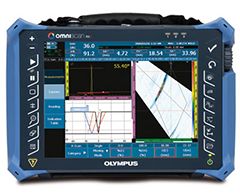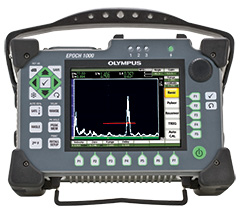3.1 General Description of Flaw Detectors
Modern ultrasonic flaw detectors are small, portable, microprocessor-based instruments suitable for both shop and field use. They generate and display an ultrasonic waveform that is interpreted by a trained operator, often with the aid of analysis software, to locate and categorize flaws in test pieces. They will typically include an ultrasonic pulser/receiver, hardware and software for signal capture and analysis, a waveform display, and a data logging module. While some analog-based flaw detectors are still manufactured, most contemporary instruments use digital signal processing for improved stability and precision.
The pulser/receiver section is the ultrasonic front end of the flaw detector. It provides an excitation pulse to drive the transducer, and amplification and filtering for the returning echoes. Pulse amplitude, shape, and damping can be controlled to optimize transducer performance, and receiver gain and bandwidth can be adjusted to optimize signal-to-noise ratios.
Modern flaw detectors typically capture a waveform digitally and then perform various measurement and analysis function on it. A clock or timer will be used to synchronize transducer pulses and provide distance calibration. Signal processing may be as simple as generation of a waveform display that shows signal amplitude versus time on a calibrated scale, or as complex as sophisticated digital processing algorithms that incorporate distance/amplitude correction and trigonometric calculations for angled sound paths. Alarm gates are often employed to monitor signal levels at selected points in the wave train to flag echoes from flaws.
The display may be a liquid crystal, an electroluminescent display, or in older models a CRT. The screen will typically be calibrated in units of depth or distance. Multicolor displays can be used to provide interpretive assistance.
Internal data loggers can be used to record full waveform and setup information associated with each test, if required for documentation purposes, or selected information like echo amplitude, depth or distance readings, or presence or absence of alarm conditions.

